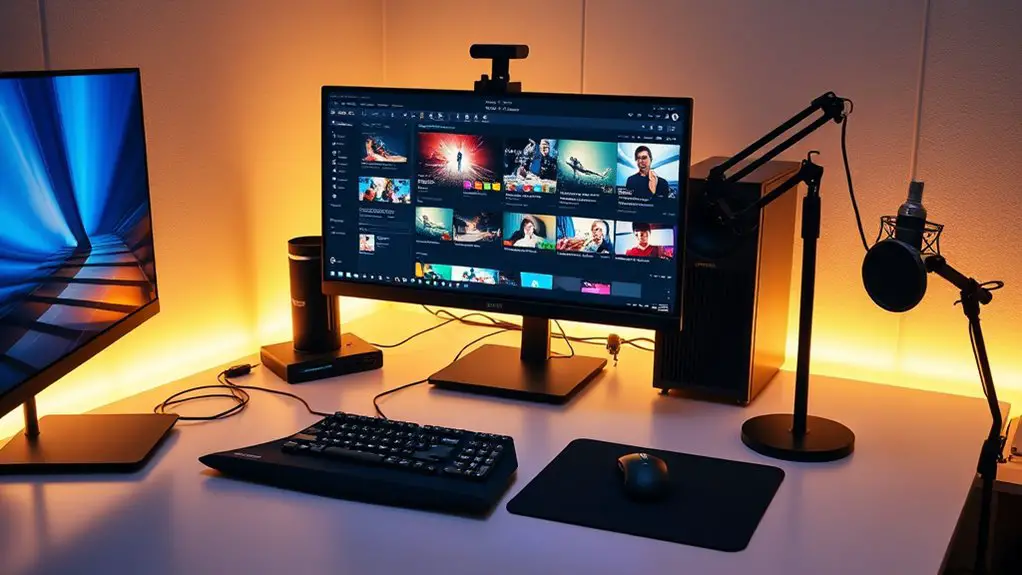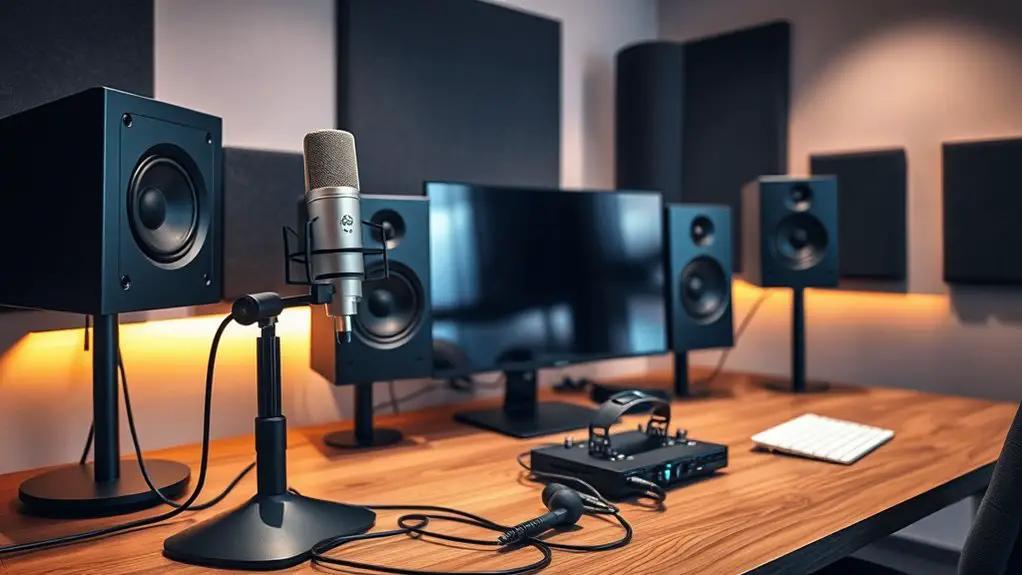To create the best setup for video editors and content creators, you'll want powerful hardware like a robust CPU, a dedicated GPU, and at least 16GB of RAM. A fast SSD and high-resolution monitor will enhance performance too. Choose software that suits your needs, like Adobe Premiere Pro or Final Cut Pro. Don't forget ergonomic accessories for comfort, quality audio equipment, and proper lighting. With the right organization and workflow tips, your editing experience can truly shine. Discover more insights along the way!
Table of Contents
Key Takeaways
- Invest in powerful hardware, including a robust CPU, GPU, and at least 16GB RAM for efficient video editing performance.
- Choose professional software like Adobe Premiere Pro or Final Cut Pro for comprehensive editing capabilities and user-friendly interfaces.
- Utilize high-resolution monitors with accurate color representation to enhance the editing experience and ensure quality output.
- Incorporate ergonomic accessories such as adjustable chairs and sit-stand desks to promote comfort and productivity during long editing sessions.
- Organize your workspace and streamline workflows with project templates and keyboard shortcuts to boost creativity and efficiency.
Essential Hardware for Video Editing

When you're diving into video editing, having the right hardware can make all the difference in your workflow and final product.
Start with a powerful CPU, as it'll handle rendering and processing tasks smoothly. Pair it with a robust GPU to accelerate rendering times and improve playback quality.
Don't overlook RAM; at least 16GB is essential for seamless multitasking. A fast SSD will greatly reduce load times and enhance overall performance, so consider it for your main drive.
A high-resolution monitor is also vital; it'll help you see your edits clearly and accurately.
Finally, invest in reliable peripherals like a quality mouse and keyboard, which can enhance your editing experience markedly.
Optimize your setup, and you'll enjoy a more efficient editing process.
Choosing the Right Software
When it comes to video editing, selecting the right software is essential for your workflow.
You'll want to contemplate popular options and their key features to find what suits your needs best.
Let's explore the top choices and what each one brings to the table.
Popular Editing Software Options
Choosing the right editing software can greatly impact your workflow and the quality of your final product.
With so many options available, it's essential to find one that suits your needs and skill level. Here are some popular software options to take into account:
- Adobe Premiere Pro: A professional-grade tool with extensive features for advanced editing.
- Final Cut Pro: Ideal for Mac users, offering a user-friendly interface and powerful performance.
- DaVinci Resolve: Known for its color correction capabilities, it's perfect for those focused on visual aesthetics.
- Filmora: Great for beginners, this software offers a simple design and a range of creative tools.
Choose wisely, and your editing process will become smoother and more enjoyable!
Key Features to Consider
Finding the right editing software isn't just about brand names or popularity; it's also about understanding the key features that can enhance your editing experience.
First, look for an intuitive interface; you want something that feels comfortable and easy to navigate. Next, consider the software's compatibility with various file formats, as this will save you time on conversions.
Performance is vital, too; make sure it supports high-resolution editing without lag. Additionally, check for robust color grading and audio editing tools to elevate your projects.
Finally, explore collaboration features if you often work with a team. By focusing on these essential elements, you can select software that not only meets your needs but also streamlines your editing process.
Monitors: Size and Resolution Matters

As you immerse yourself in the world of video editing and content creation, the right monitor can greatly impact your workflow and final output.
Size and resolution play vital roles in guaranteeing you see every detail. Here are some factors to take into account when choosing your monitor:
- Screen Size: A larger screen helps you view timelines and details more comfortably.
- Resolution: Aim for at least 1080p; 4K provides even sharper images, essential for high-quality edits.
- Color Accuracy: Look for monitors that cover a wide color gamut to guarantee your edits reflect true colors.
- Aspect Ratio: A 16:9 ratio is standard, but ultra-wide monitors can enhance multitasking.
Choosing the right monitor can elevate your editing experience and improve your content quality.
Ergonomic Accessories for Comfort
Having the right monitor sets the stage for a productive editing environment, but comfort is just as important when you're spending long hours in front of the screen.
Ergonomic accessories can make a world of difference. Start with an adjustable chair that supports your lower back; it'll help you maintain good posture. Consider a sit-stand desk so you can switch positions throughout the day.
Invest in ergonomic accessories like an adjustable chair and sit-stand desk to enhance comfort and maintain good posture while you work.
A wrist rest for your keyboard and mouse can alleviate strain, while a monitor stand positions your screen at eye level, reducing neck tension.
Finally, invest in a footrest to promote circulation. These small adjustments can enhance your comfort, boost productivity, and help you focus on creating amazing content without the aches and pains.
Audio Equipment for Professional Sound

When it comes to achieving professional sound, the right audio equipment is essential.
You'll want to focus on high-quality microphones for clarity and reliable audio interfaces to guarantee seamless recording and playback.
Let's explore how these tools can elevate your projects.
Microphones for Clarity
To achieve professional sound quality in your video projects, investing in a high-quality microphone is essential. The right mic can greatly enhance clarity and guarantee your audio stands out.
Here are some key types to take into account:
- Dynamic Microphones: Great for loud environments, they're durable and handle high sound levels well.
- Condenser Microphones: Ideal for capturing subtle details, these mics excel in studio settings.
- Lavalier Microphones: Perfect for interviews or presentations, they're discreet and clip onto clothing.
- Shotgun Microphones: Excellent for directional sound, they're perfect for capturing audio from a distance.
Choosing the right microphone tailored to your needs will elevate the quality of your content, making it more engaging for your audience.
Audio Interfaces Importance
While you might focus on choosing the right microphone, don't overlook the importance of an audio interface in your setup.
An audio interface acts as the bridge between your microphone and your computer, converting analog signals into digital sound. This process guarantees that you're capturing high-quality audio without unwanted noise or distortion.
Plus, many interfaces offer features like phantom power for condenser mics, multiple inputs for recording multiple sources simultaneously, and direct monitoring to hear your audio in real-time.
By investing in a reliable audio interface, you'll elevate your sound quality, making your content more professional and engaging.
Storage Solutions for Large Files
As video editors and content creators accumulate vast amounts of footage and project files, finding efficient storage solutions becomes essential.
You need options that guarantee quick access and reliability. Here are some storage solutions to examine:
- External Hard Drives: Affordable and portable, perfect for backing up files.
- Network Attached Storage (NAS): Great for collaborative projects, allowing multiple users to access files simultaneously.
- Cloud Storage: Offers flexibility and accessibility from anywhere, plus automatic backups.
- Solid State Drives (SSD): Fast read/write speeds, ideal for working with large files in real-time.
Lighting Equipment to Enhance Visuals
Good lighting can transform your video projects, elevating them from ordinary to exceptional. To achieve professional results, consider investing in key lighting equipment.
Start with softbox lights, which diffuse harsh light and create a flattering, even glow. LED panels are versatile and energy-efficient, allowing you to adjust brightness and color temperature easily.
For dramatic effects, use a ring light to enhance facial features and eliminate shadows. Don't forget about practical lights, like lamps or string lights, which add depth and atmosphere to your scenes.
Finally, always pay attention to your light placement; three-point lighting setups can create depth and dimension. With the right lighting, your visuals will captivate audiences and convey your message powerfully.
Organizing Your Workspace for Efficiency
To maximize your productivity as a video editor or content creator, organizing your workspace is essential. A clutter-free environment not only boosts creativity but also helps you focus on your projects.
Organizing your workspace is crucial for enhancing productivity and maintaining focus as a video editor or content creator.
Here are some tips to create an efficient workspace:
- Designate zones: Create specific areas for editing, brainstorming, and relaxation.
- Declutter regularly: Keep only what you need on your desk and store away unnecessary items.
- Cable management: Use clips or ties to organize cables, preventing tangles and distractions.
- Personalize your space: Add elements that inspire you, like artwork or motivational quotes, to make your workspace inviting.
Tips for Streamlining Your Workflow
With your workspace organized for maximum efficiency, it's time to focus on streamlining your workflow.
Start by creating a project template that includes your most-used settings, assets, and effects. This saves you valuable time during each new project.
Utilize keyboard shortcuts to speed up editing tasks, and consider customizing them to fit your style.
Batch process similar tasks, like color grading or audio adjustments, to maintain your creative flow.
Don't forget to back up your work regularly, using automated tools to eliminate manual backups.
Finally, take breaks to recharge; a fresh perspective can enhance your creativity.
Frequently Asked Questions
What Is the Ideal Internet Speed for Uploading Videos?
For uploading videos, you'll want at least 10 Mbps for standard uploads, but faster speeds like 25 Mbps or more are ideal. This guarantees quick uploads without interruptions, enhancing your overall workflow and efficiency.
How Often Should I Upgrade My Editing Equipment?
You should consider upgrading your editing equipment every two to three years, especially if you notice slow performance or new software demands. Staying current guarantees you maintain efficiency and quality in your projects.
Can I Edit Videos on a Laptop Effectively?
Yes, you can edit videos on a laptop effectively. Just guarantee it has a powerful processor, sufficient RAM, and a dedicated graphics card. With the right tools, you'll achieve great results without needing a desktop.
What Are Some Common Beginner Mistakes in Video Editing?
When you start video editing, you might rush through the process, ignore organization, or overlook audio quality. Don't forget to experiment and learn from your mistakes; it's all part of developing your skills and style.
How Do I Choose the Right Video Format for Export?
To choose the right video format for export, consider your audience and platform requirements. For online sharing, MP4 is popular. If you need higher quality, try MOV. Always balance quality with file size for ideal results.




